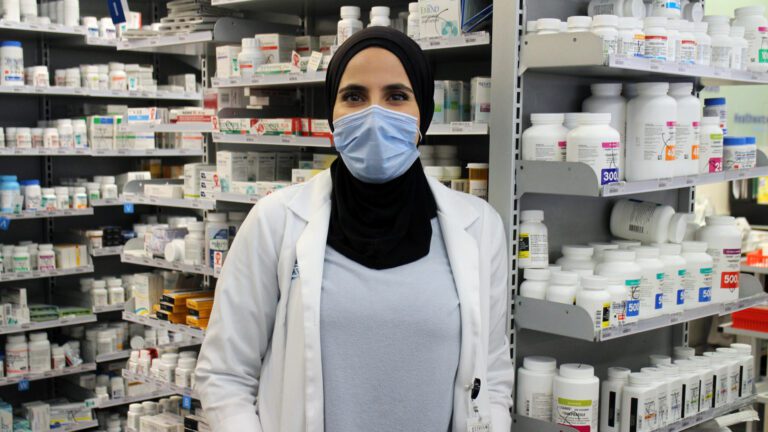
Edmonton pharmacist Eman Saleh was aware that the ongoing opioid crisis is being exacerbated by the COVID-19 pandemic. She had watched news stories about it, and then a few weeks after those stories, she experienced it firsthand in her pharmacy.
One evening in August, a man walked into the pharmacy and asked for a naloxone kit. This is not unusual at Eman’s pharmacy, but this was unlike any other request.
“I looked up, and I saw him sitting down. He could barely sit up straight. I asked him what was going on, and he asked us to give him naloxone because he had just overdosed,” explained Eman.
“At first I was a little shocked, as I’ve never been in that situation,” continued Eman. “It’s a regular thing that we have people coming in and asking for kits – but then when I heard him asking ‘can you give it [naloxone] to me,’ I looked and thought, ‘oh dear.’”
Eman took the man into a counselling room. He exposed his thigh without being asked.
“It was almost like he knew what to do to get ready but had never administered it to himself before,” said Eman.
She gave him a dose. He tried to convince her to give him the second dose right away and not call 911. Eman stuck to the protocol and made him wait for the five minutes before administering the second dose, and she called 911.
“He’s slowly dozing off within those five minutes, and I’m trying to keep him awake. I’ve got a hand on him,” remembers Eman. “And then I gave him his second dose and within 30 seconds, it’s almost like he woke up, grabbed some tissues, wiped his face and said, ‘I’m good.'”
The man did stay at the pharmacy and allowed the paramedics to check and monitor him. This care, and the naloxone, avoided a trip to the hospital. As the man left though, Eman made sure he had a naloxone kit to take with him.
Eman recounted the experience on her Twitter account because she says it was an eye-opening experience for her, and she wanted to share it with others.
Alberta Health Services’ quarterly reports show that in 2019, 603 Albertans died from an apparent accidental drug poisoning death related to fentanyl/opioids. In the first three months of 2020, that number is at 142. The COVID-19 pandemic is expected to make the situation worse. Supervised consumption sites must adhere to physical distancing guidelines that reduce their capacity. Individuals with substance use disorder are at higher risk as they may avoid these and other support services during the pandemic for fear of contracting COVID-19, while others may be experiencing depression from isolation or financial troubles related to COVID-19.
“The fact I saw this on the news and then have it happen to me, it’s important to know how to use naloxone kits and how to respond in emergency situations,” said Eman.
If your pharmacy is interested in becoming a distribution site for the Community Based Naloxone Program, site registration forms, staff training materials, and other resources can be found on the AHS Community Based Naloxone Program webpage. Pharmacy team members who provide naloxone can learn more about their responsibilities and the expectations of ACP by reviewing the Providing naloxone as an unscheduled drug: Guidelines for pharmacy teams document.




